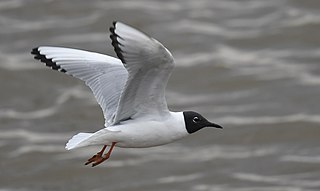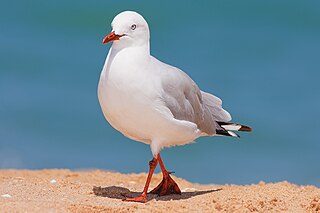
Gulls, or colloquially seagulls, are seabirds of the family Laridae in the suborder Lari. They are most closely related to the terns and skimmers and only distantly related to auks, and even more distantly to waders. Until the 21st century, most gulls were placed in the genus Larus, but that arrangement is now considered polyphyletic, leading to the resurrection of several genera. An older name for gulls is mews, which is cognate with German Möwe, Danish måge, Swedish mås, Dutch meeuw, Norwegian måke/måse and French mouette, and can still be found in certain regional dialects.

Larus is a large genus of gulls with worldwide distribution.

The black-headed gull is a small gull that breeds in much of the Palearctic including Europe and also in coastal eastern Canada. Most of the population is migratory and winters further south, but some birds reside in the milder westernmost areas of Europe. Small numbers also occur in northeastern North America, where it was formerly known as the common black-headed gull. As is the case with many gulls, it was previously placed in the genus Larus.

Bonaparte's gull is a member of the gull family Laridae found mainly in northern North America. At 28 to 38 cm in length, it is one of the smallest species of gull. Its plumage is mainly white with grey upperparts. During breeding season, Bonaparte's gull gains a slaty-black hood. The sexes are similar in appearance.

Franklin's gull is a small gull. The genus name Leucophaeus is from Ancient Greek leukos, "white", and phaios, "dusky". The specific pipixcan is a Nahuatl name for a type of gull.

The red-billed gull, also known as tarāpunga and once also known as the mackerel gull, is a native of New Zealand, being found throughout the country and on outlying islands including the Chatham Islands and subantarctic islands. It was formerly considered a separate species but is now usually treated as a subspecies of the silver gull.

The grey-headed gull, also known as the gray-hooded gull, is a small species of gull which breeds patchily in South America and Africa south of the Sahara. It is not truly migratory, but is more widespread in winter. This species has occurred as a rare vagrant to North America, Italy and Spain. As is the case with many gulls, it has traditionally been placed in the genus Larus.

The silver gull is the most common gull of Australia. It has been found throughout the continent, but particularly at or near coastal areas. It is smaller than the Pacific gull, which also lives in Australia.

Hartlaub's gull, also known as the king gull, it is a small gull. It was formerly sometimes considered to be a subspecies of the silver gull, and, as is the case with many gulls, it has traditionally been placed in the genus Larus but is now placed in the genus Chroicocephalus. The species’ name commemorates the German physician and zoologist, Gustav Hartlaub.

The black-billed gull, Buller's gull, or tarāpuka (Māori) is a Near Threatened species of gull in the family Laridae. This gull is found only in New Zealand, its ancestors having arrived from Australia around 250,000 years ago.

The brown-hooded gull is a species of gull found in Argentina, Brazil, Chile, the Falkland Islands, and Uruguay. Its specific epithet, maculipennis, means 'spotted wings'. It is a white bird with a brown head and red beak and feet.
Larus elmorei is an extinct species of gull that lived during the mid-Pliocene.
Larus oregonus is an extinct species of gull that lived during the Late Pleistocene.
Larus robustus is an extinct species of gull that lived during the Late Pleistocene.
Larus perpetuus is an extinct species of gull that lived in North America during the Pliocene.










